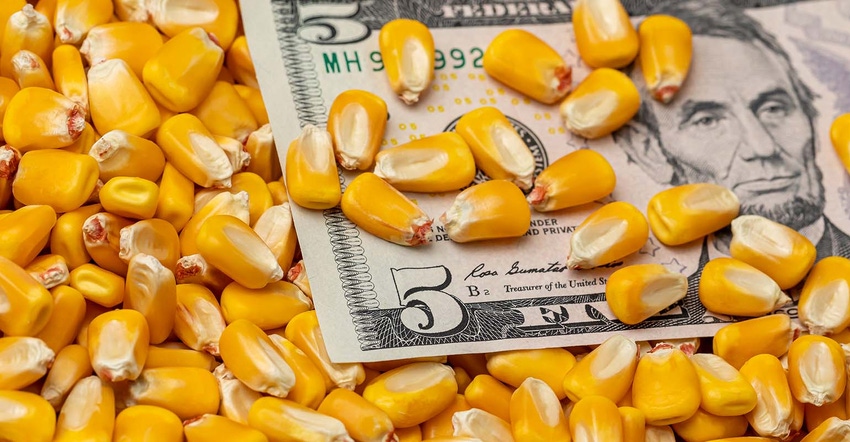
Harvest pressure, rumors of larger yields, technical chart selling, and fears that the USDA will increase acreage on Friday’s Sept. 10 USDA report have nudged corn futures prices lower toward the $5 support area for the December contract.
Looking back over the spring and summer, there were only 12 business days where December 2021 corn futures traded at or above $6; six days in May, five days in June, and one day in early July. The rest of that time, December futures primarily stayed between $5.25 and $5.75.
Heading into Friday’s USDA report, December 2021 corn futures are approaching the illustrious $5.00 support area. Price were near here once in late May, once in mid-July, and now again ahead of a very important USDA report.
Why is this report so important?
Traditionally the September WASDE report offers little fresh news with only slight adjustments. This year will be different. The agency shocked many when they stated on Sept. 1 that, “USDA's National Agricultural Statistics Service will review all available data, including survey data, satellite-based data, and the latest information from USDA's Farm Service Agency and Risk Management Agency, for planted and harvested acreage for corn, cotton, peanuts, rice, sorghum, soybeans, and sugar beets in preparation for the September Crop Production report.”
If the data review justifies any changes, NASS will publish updated planted and harvested acreage estimates in the Sept. 10 report.
It is normal practice for NASS to review these data in September for cotton, peanuts, and rice. The review typically takes place in October for corn, sorghum, soybeans, and sugar beets, however the data are sufficiently complete this year to consider adjustments in September. In October, NASS will again review acreage for corn, sorghum, soybeans, and sugar beets as well as for canola, dry edible beans, and sunflowers.”
You read it, if the data review justifies changes, it will be published in the form of updated planted and harvested acres on Friday’s report.
What, me worry?
What’s everyone worried about? Much of the industry is looking for an increase in corn acres, and an increase to corn yield. If true, ending stocks are likely to grow.
Current ending stocks for new crop corn, the 2021/22 crop year are pegged at 1.242 billion bushels, which was a decrease from 1.432 billion bushels from the July report. According to pre-report estimates for Friday, traders think new crop ending stocks will be pegged near 1.329 billion bushels (with a range of 1.018 to 1.545 billion bushels).
Here is what you need to look for. If ending stocks come in higher than 1.329 billion bushels, that will likely continue to weigh on corn futures prices and ending stocks will be perceived to be growing. If ending stocks come in larger than 1.5 billion bushels, watch out for a price wash out.
However, if the USDA makes very few adjustments on this report, which is expected to be bearish, and if ending stocks come in smaller than 1.329 billion bushels, that would be a reason for new crop corn futures to potentially find strong support at the $5 price range, and a harvest low.
Reach Naomi Blohm: 800-334-9779 Twitter: @naomiblohm and [email protected]
Disclaimer: The data contained herein is believed to be drawn from reliable sources but cannot be guaranteed. Individuals acting on this information are responsible for their own actions. Commodity trading may not be suitable for all recipients of this report. Futures and options trading involve significant risk of loss and may not be suitable for everyone. Therefore, carefully consider whether such trading is suitable for you in light of your financial condition. No representation is being made that scenario planning, strategy or discipline will guarantee success or profits. Any decisions you may make to buy, sell or hold a futures or options position on such research are entirely your own and not in any way deemed to be endorsed by or attributed to Total Farm Marketing. Total Farm Marketing and TFM refer to Stewart-Peterson Group Inc., Stewart-Peterson Inc., and SP Risk Services LLC. Stewart-Peterson Group Inc. is registered with the Commodity Futures Trading Commission (CFTC) as an introducing broker and is a member of National Futures Association. SP Risk Services, LLC is an insurance agency and an equal opportunity provider. Stewart-Peterson Inc. is a publishing company. A customer may have relationships with all three companies. SP Risk Services LLC and Stewart-Peterson Inc. are wholly owned by Stewart-Peterson Group Inc. unless otherwise noted, services referenced are services of Stewart-Peterson Group Inc. Presented for solicitation.
The opinions of the author are not necessarily those of Farm Futures or Farm Progress.
About the Author(s)
You May Also Like






